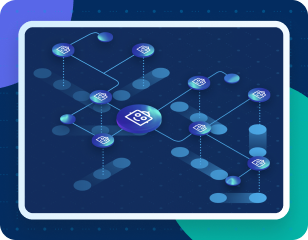As enterprises race to harness the power of AI, many are discovering that intelligent agents, automation tools, and integration frameworks can either elevate the business or entangle it in complexity. The key to staying in control isn’t just more technology; it’s the right architecture and design. Specifically, architecture with embedded governance that guides smart, sustainable decisions in the age of agentic transformation.
AI, integration, and automation aren’t isolated capabilities; they’re converging pillars of a new, actionable operating model. Navigating this shift demands more than shiny tools. It requires a smart, adaptable architecture so let’s break it down.
The rise of agentic systems
Agentic systems, where AI agents autonomously take actions, learn, adapt, and collaborate with humans, are no longer a future concept. From Agentforce-powered sales and service agents to orchestration agents like MuleSoft AI Chain, we’re seeing these capabilities emerge across the enterprise stack.
But here’s the catch: the more responsibility and autonomy we give to AI agents, the greater the need for governance. Without the right architecture principles in place, things can quickly spiral out of control, e.g. hallucinating models, shadow integrations, security loopholes, and automation spaghetti.
It’s not just AI agents that need governing. These principles must also extend to the underlying capabilities that an agentic architecture depends on.
Composability as the foundation for an agentic architecture
Many enterprises still run on tightly coupled applications, stitched together by point-to-point integrations, with data locked away in silos that are hard to access. This complexity makes organisations inefficient and slow to respond – whether to business strategy shifts or emerging market threats and opportunities.
The answer? A composable architecture built on highly reusable building blocks — in the form of MuleSoft APIs and automations — that deliver seamless, connected digital experiences. These building blocks are business-oriented, abstract complexity from core systems, and are secure, governed, agile, and designed for reuse from the start. To unlock true actionability, enterprises must harness composability not just to connect systems, but to transform those connections into measurable business outcomes.
This composable foundation enables the emergence of an agentic architecture, where AI agents create intuitive, human-centric experiences. This is achieved by combining an Agentic platform like Agentforce and a connectivity platform like MuleSoft with its AI Chain capability. These agents can listen, engage, and respond to user needs with insights grounded in the right data (e.g. “where’s my order?” or “when will it arrive?”). They can also take action (e.g. “change the delivery address” or “schedule an installation”).
So how do we enable trustworthy, scalable and adaptive AI agents that evolve responsibly?
6 pillars of a composable, agentic architecture
At MuleSoft, we define six key architectural pillars that underpin a scalable, secure, and intelligent enterprise:
- Security: Protect AI Agents from malicious attacks and unintended access.
- Reliability: Ensure agents are consistently available and scalable.
- Performance: Deliver fast, efficient AI execution without bottlenecks.
- Operational efficiency: Make AI easy to support, govern, and adapt.
- Reusability: Maximize ROI with modular, reusable components.
- Sustainability: Design for responsible, ethical, and long-term use.
These pillars ensure that your architectural solutions are robust and aligned with business needs. Each pillar isn’t just a checkbox. It’s a lens through which we evaluate AI, integration, and automation initiatives. Whether you’re deploying an AI-powered customer support agent or automating document workflows, these principles act as your guide and compass to ensure the right technology is selected for the right use case while being grounded in architecture best practice.
The diagram below illustrates the pillars of a well-architected composable and agentic architecture, all supported by embedded governance.
To scale AI responsibly, we don’t just build faster; we need to build smarter – with key principles that govern every agent.
Principles that govern agentic AI
To architect AI that’s scalable, secure, and business-aligned, we anchor our approach around a clear set of Enterprise Architecture principles. These principles are organized across each key pillar to guide how AI agents are designed, deployed, and governed. The table below provides details of these foundational principles by pillar:
| Pillar | Principle Name | Statement |
|---|---|---|
| Security | Zero-Trust Security for AI | AI systems must be secured using a zero-trust architecture where no user, model, data source, or action is implicitly trusted & continuous verification is enforced across the service chain |
| Compliance by Design | AI solutions must be architected to comply with relevant geographic and industry regulations (e.g. GDPR, AI Act, HIPAA) | |
| Reliability | Lifecycle Governance | AI systems must be governed across their entire lifecycle from experimentation and deployment to monitoring, evolution, and retirement. |
| Model Transparency & Explainability | AI models must provide clear, traceable reasoning for their outputs. | |
| Performance | Performant & Scalable AI | AI systems must be architected to scale with business demand while maintaining reliable performance and cost efficiency |
| Operational Efficiency | Business-Driven AI | AI initiatives must be aligned with defined business outcomes, measurable KPIs, and the overarching enterprise strategy to ensure value delivery |
| Platform-Aligned vs Independent AI Agents | AI agents must be selected and architected based on their alignment with enterprise platforms, security boundaries, and intended use cases – leveraging on-platform agents for embedded efficiency and independent agents for cross-platform orchestration or innovation | |
| Vendor & Model Agnostic | AI architectures must be designed for interoperability across models, providers, and deployment environments (e.g. cloud, on-prem, edge) to enable flexibility, resilience, and rapid adaptation to emerging capabilities. | |
| Reusability | Composable AI | AI capabilities (e.g. AI agents, data pipelines, model components) must be designed as modular, composable services to maximize reuse across the enterprise |
| Data Centricity | AI success depends on high-quality, well-governed, and accessible data treated as a first-class asset throughout the lifecycle | |
| Sustainability | Responsible & Ethical AI | AI systems must be designed, developed, and governed to ensure fairness, accountability, transparency, and safety aligned with the organization’s ethical standards and societal expectations. AI systems should also be designed to minimize environmental impact. |
Now that we’ve covered the why and the what, let’s explore how these principles show up in the real world.
Bringing the pillars to life: Architecture principles in action
Let’s explore how each domain (AI, integration, and automation) benefits from applying these principles.
1. AI needs guardrails, not guesswork
When architecting AI systems:
- Apply zero-trust security so that every data source, prompt, and model action is verified.
- Ensure lifecycle governance so you can track, update, and retire AI assets.
- Test and monitor AI systems in real-world conditions. AI is non-deterministic, so testing shouldn’t end in pre-production. Models must be constantly audited and adjusted to stay aligned with evolving data and business needs.
- Embrace business-driven AI to keep the focus on outcomes, not just outputs.
- Adopt data centricity as AI success depends on high-quality, well-governed, and accessible data – treated as a first-class asset throughout the lifecycle.
- Design for responsible and ethical AI to ensure fairness, transparency, and trust.
2. Integration is the glue
Integration can either enable hyperautomation or cripple it so EA principles help by:
- Securing APIs by design and ensuring compliance with data protection and residency laws.
- Enforcing an API-first approach with built-in observability to drive reliable, scalable integrations.
- Optimizing performance through efficient design and event-driven architectures where appropriate.
- Streamlining delivery and operations with lightweight governance and automated CI/CD pipelines.
- Maximizing reusability through modular, composable integration assets.
- Leveraging open standards (e.g. REST, MCP, and A2A) to maximize interoperability, ensure compatibility, and future-proof your integration investments.
- Embedding sustainability via efficient design and continuous, data-driven Optimization.
3. Automation needs purposeful design
Automation is powerful, but only when it’s aligned with strategy:
- Embed security and compliance from the start to protect sensitive processes and data.
- Ensure end-to-end visibility and governance for reliable and accountable automation.
- Optimize performance by designing scalable, low-latency automations.
- Align automation with strategic goals to avoid tactical, siloed efforts.
- Empower human and AI collaboration to enhance decision-making, not replace it.
- Balance business agility with IT governance for safe, scalable automation delivery.
- Choose the right tool for the right use case to avoid duplication and inefficiency.
- Design with reusability and composability to accelerate delivery and reduce technical debt.
- Improve with sustainability in mind to optimize impact and efficiency over time.
Why it all matters
AI, integration, and automation are converging into a single, intelligent ecosystem – one that powers how modern enterprises operate, serve, and adapt. For that ecosystem to thrive, architecture principles must:
- Govern without slowing things down
- Enable innovation without chaos
- Protect users and systems without adding friction
We need an enterprise architecture that’s fit for an agentic future. Whether you’re building AI agents, automating claims processes, or reimagining supply chains, this is your opportunity to drive change on your terms so let’s architect with intention.
Keeping the curiosity alive
Engage with us to see how MuleSoft and Agentforce embed these principles into the solution lifecycle with tools, governance, and control baked in. By partnering with MuleSoft and Agentforce, you can ensure your agentic transformation journey is well-guided, grounded in architecture best practice and delivers measurable business outcomes.
Architecture principles may not be glamorous, but they’re your unfair advantage in a world run by intelligent agents. We’re here to help you build smarter, safer, and more scalable systems in the age of agentic transformation, so reach out for more details or connect with us to dive deeper.









